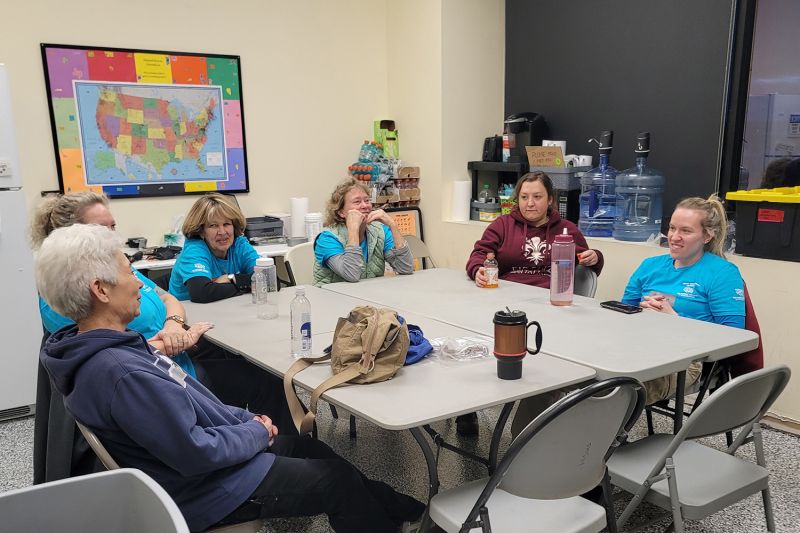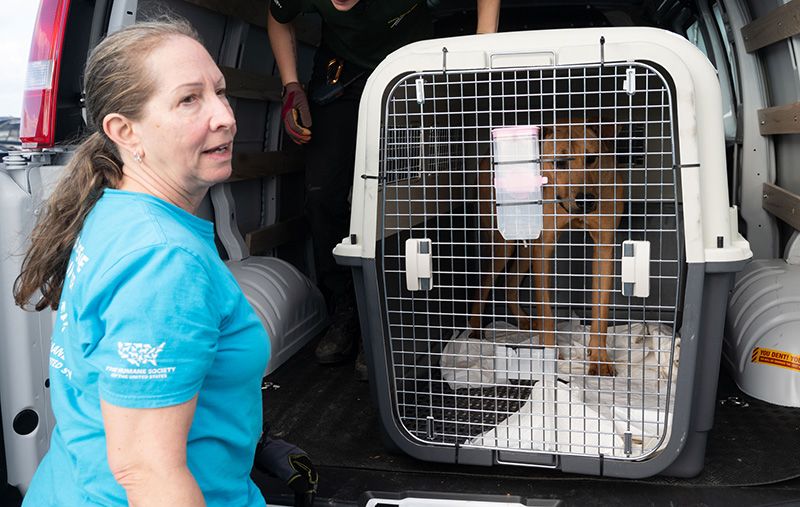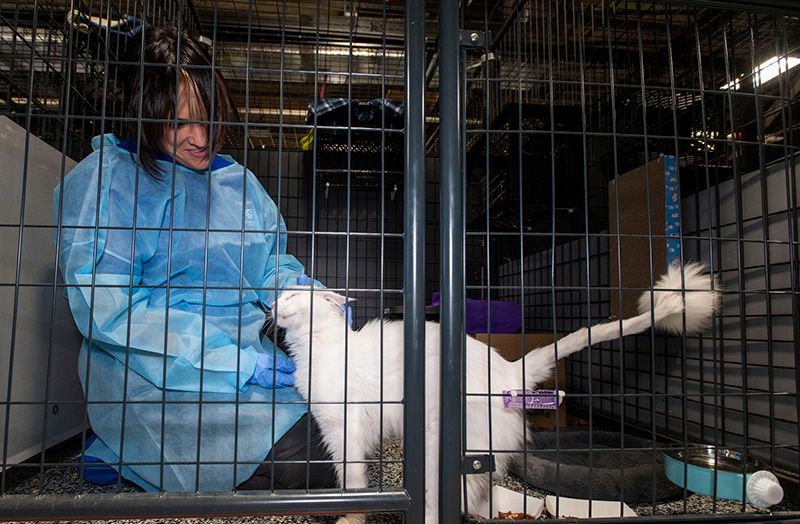Blog: Bonding over a shared mission
What it’s like to volunteer with traumatized animals at our care and rehabilitation center
December 19, 2023

As I checked into the hotel the afternoon before my volunteer stint began, the woman at the front desk told me that I would find “my people” the next day at breakfast.
“They will all be wearing blue shirts. You won’t miss them,” she said.
She was right. The next morning, I received my own blue shirt and started to get acquainted with my fellow volunteers, many of whom had been here several times before. I met a retired nurse from Arizona and her husband, a retired nurse practitioner who served in the Navy. There was a retired teacher, a woman who runs a cat sanctuary in Oregon, and a business executive who was volunteering for morning shifts so that he could work with his West Coast office in the afternoons.
We were all here in this rural part of Maryland with one goal in mind: to help animals heal from their traumatic pasts.

The Humane Society of the United States, with Humane Society International, opened a care and rehabilitation center in 2020 to temporarily house animals from large-scale rescue efforts. Since then, thousands of animals have passed through its doors, including sensory-deprived pups from breeding mills who have never experienced the feel of grass beneath their paws, dogs and cats from large-scale neglect situations, and victims of dogfighting who have endured horrendous abuse.
At the center, the animals receive intensive medical and behavioral rehabilitation, helping them regain their trust of people in the hope that they can be transferred to HSUS shelter and rescue partners for adoption.

Since joining the staff of the Humane Society Veterinary Medical Association, an HSUS affiliate, in 2017, I’d long wanted to join one of our Animal Rescue Team’s deployments and help remove animals from the awful situations I regularly read about in our news alerts. But deployments are unpredictable, and I hadn’t been able to fit a trip into my hectic work schedule. The Maryland facility, which needs volunteers year-round, was the perfect alternative. I signed up for a week in August when my regular workload was lighter.
As I drove the short distance from the hotel to the care center for the first time, I wasn’t sure what to expect, but I was excited to meet some of the animals whose cases I’d read about.
Like the volunteers, the animals came from all over the country and even abroad. There were some large Tosas rescued from a dog meat farm in South Korea and several pit-bull types confiscated from an alleged dogfighting case in North Carolina. There were also dozens of Australian shepherds and mixes from an alleged puppy mill operation in North Carolina. I was assigned to the Aussies, working alongside a seasoned volunteer from Chicago who showed me the ropes.
Every day had a structured schedule, starting with the morning orientation when staff would talk about the plan for the day and discuss any medical or behavioral cases. There were dogs with mange or heartworm disease who received daily medications and ones with severe anxiety that warranted some pharmaceutical treatment. Each dog’s case was unique, and the medical and behavior teams worked together to come up with a plan for their care.
The Aussies were among the most recent arrivals, and their socialization skills varied widely. Some were reserved and watchful, always cautious, or anxious and hiding in their kennels. Others were eager to get into an activity pen and expend their energy.

As we fed dogs and cleaned their kennels, we had to be thoughtful with every task. Opening a garbage bag by catching air and swinging it up and down wasn’t going to go over well if you were near a dog who feared every noise. We spoke in soft voices and didn’t force contact with our wards, not an easy task when you want to shower them with affection. We respected each animal’s boundaries, knowing that patience and a safe, structured environment was what they most needed.
The dogs are housed in large kennels, which means a lot of shoveling soiled wood shavings. If you’ve ever mucked out a horse’s stall, you’re familiar with this drill. I was assigned to about a dozen kennels each day and enjoyed seeing the dogs’ different personalities revealed as they became familiar with my presence. I fell in love with Pretzel, a quiet little Aussie who, due to inbreeding, had a severe overbite and a tongue that stuck out.
While my group was still settling into their new environment, I got to see some of the work with dogs who were further along in their stays. They romped in activity pens, learned basic obedience skills or explored the outdoors on leashes. It was all very organized, with activities tailored to each dog’s needs.
A two-hour lunch break enabled volunteers to rest aching muscles from the morning’s manual labor and also provided a stretch of quiet time for the animals, which research shows helps to reduce stress in a shelter environment. After lunch, volunteers gathered together to create puzzle boxes, special treats and other enrichment activities for the next day. I learned to love the time of day when I got to dip my gloved hand into a 10-gallon bucket of creamy peanut butter (who knew you could buy it in this size!) and spread it on Nylabones to be frozen as enrichment treats.
The volunteers got to know each other during this time, and as I listened to everyone’s stories and backgrounds, I saw how devoted our volunteers truly are. The focus on the well-being of the animals in their care was paramount, and any time spent making a connection with one of the animals was a perk. Everyone had their favorites, me included, but each animal made us hopeful that their second chance to find a loving home was just around the corner.
Learn more about our care and rehabilitation center and how you can volunteer.

